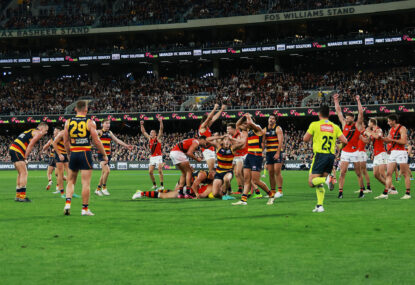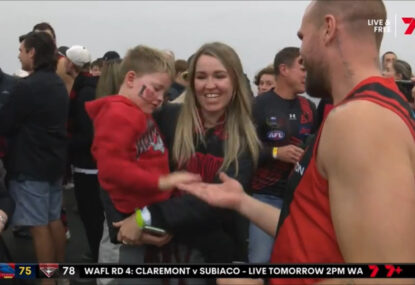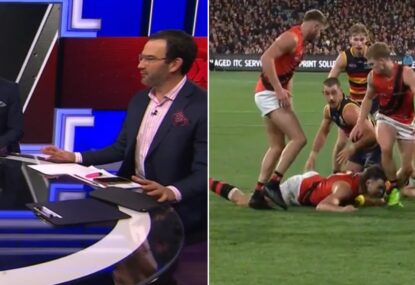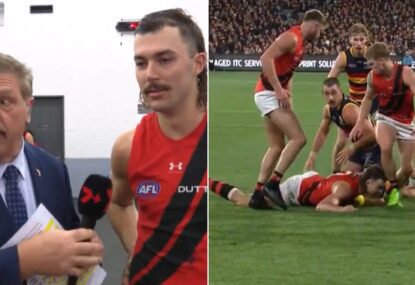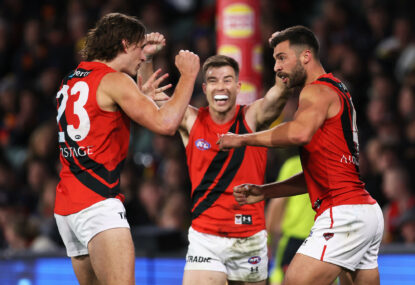As the lady Bulldogs were trying to come back on Carlton in the fourth quarter on Sunday, the commentators were interrogating each other as to which players had gotten worse since the previous year’s premiership season.
They struggled to name names – not just out of courtesy, trying to avoid unnecessary defamation, but because there really isn’t anything significantly worse about the Doggies.
It’s just that the rest of the league has gotten markedly better.
As a couple of different writers on this site – including me – have pointed out the women’s professional game has literally transformed over the last two months.
One of the keys to the Bulldogs’ comeback during the first portion of the fourth quarter on Sunday was the absence of Carlton’s teenage superstar-in-training, Maddie Prespakis, for about five minutes of game time.
While she rested on the bench, the Dogs kicked three goals.
When she returned, the Blues returned to their previous domination, allowing only a couple more garbage-time goals at the end of the game when Carlton had wrapped the game up.
That’s how much difference the new breed of dynamic ball-movers has in the AFLW.
The explosive marking shown in Saturday’s pair of games stood in stark contrast to the Giants’ win over Geelong, a scrumming battle between two old-style teams that left the Cats limping into the finals with three wins and four losses… while the Kangaroos are staying home at 5-2 with a percentage over 120!
Because of Isabel Huntington’s after-the-season-siren goal against the Blues, all five teams in Conference B finished 2019’s home-and-away season below 100 per cent, while only the Bulldogs failed to surpass 110 per cent in Conference A.
Trivia: despite differing percentages, three of the five Conference B teams scored exactly 81 fewer points than their opposition in seven games this year, while GWS was one goal off at -87. Carlton was the odd one out with a differential of minus one.
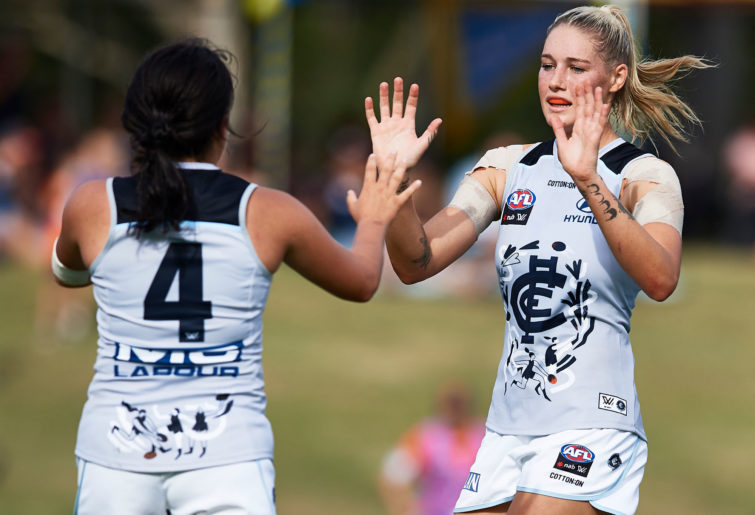
Tayla Harris of Carlton celebrates with Madison Prespakis. (Photo by Brett Hemmings/Getty Images)
That’s because of the unprojectable fact that an 80 per cent majority of teams which have brought in the athletes and coaches to play the fast, high kick-ratio game which bears more of a resemblance to the men’s AFL game happened to end up in Conference A.
And ironically, the one team that didn’t immediately embrace the change was the 2018 champion, who probably didn’t see a need to change.
The new kids (North) and the teams that finished third (Melbourne), fifth (Adelaide) and seventh (Fremantle) from last year all took the bull by the horns, while otherwise successful teams in Brisbane (second), GWS (fourth) and Collingwood until late in the season (sixth) stuck by the tried and true, as did the VFL-turned-AFL Cats.
Only Carlton – the last-placed team in 2018 – saw the same need for transformation as the leaders in the opposite conference did, and pounced on it as an opportunity to change.
You can’t blame the AFL for that.
Now, should we rearrange again for 2020?
Had the top four of a one-tier, ten-team league gone into finals, like 2018, then Melbourne would be preparing to travel to Adelaide for a rematch of their 68-8 loss this week, while North would also travel to a rematch in Fremantle.
Since we just saw the routs that resulted from those match-ups, perhaps we should be thankful for having at least the chance for something different next week!
And it’s a twist of fate that in each conference, the eventual finalists met in the teams’ one ‘official’ hit out, back on January 19.
While Geelong edged Carlton 7.4 (46) to 7.2 (44) at Ikon Park, giving a hint to the scoring potential on both sides, Adelaide and Fremantle met in Darwin, the outcome matching expectations for those of us who had watched the teams over the two years previous.
The 2017 champs won in their second home, 9.4 (58) to 5.8 (38), a 20-point win.
In a year of revolution in the AFLW, it seems appropriate to have three ‘old’ teams which each play the ‘new’, open style of footy alongside one ‘new’ team in Geelong which plays the ‘old’ style of scrum-to-scrum while looking for the opportunity to break free towards goal.
Not coincidentally, Geelong is the lowest scoring team in the comp at 22 points per game, entering finals alongside the highest scoring team in their conference (Carlton, just under 37 points per game) and the two highest in AFLW history: Fremantle, who averaged 50.4, and Adelaide, who put up a staggering 57.6 points a game this season.
Extended out to the typical length of a men’s game, by the way, Adelaide’s per-game average would reach 96 points per game, a figure that would have ranked third on the men’s ladder last season, behind only Richmond and Melbourne.
In theory, of course. In theory…
The ELO-Following Football numbers give us the generally expected result for this weekend’s tilts: an all Conference A grand final if the games run to form.
It projects a 5.9-point advantage to Fremantle traveling across the country to Melbourne to play at Carlton’s Ikon Park, and I’m also predicting the Dockers winning in what should be the better of the two match-ups.
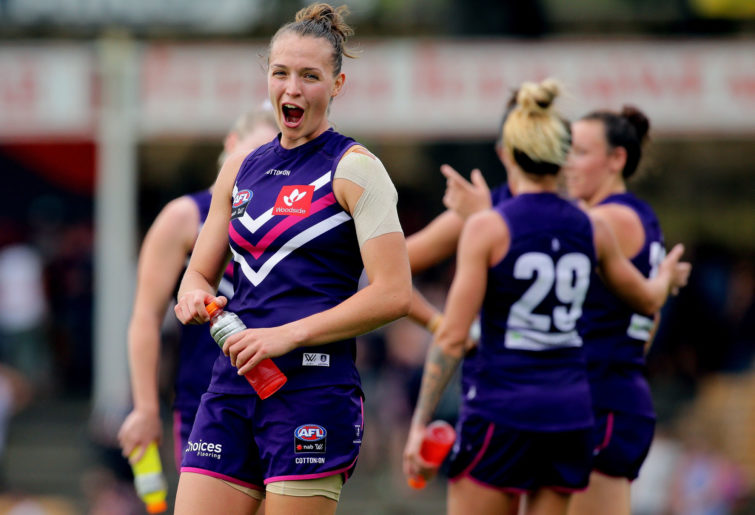
Ebony Antonio of the Dockers celebrates. (Photo by Will Russell/Getty Images)
Kiara Bowers has been the best player in the comp over the last half of the season, bar none, and while the Blues found themselves struggling with the Bulldogs when push came to shove, Fremantle defeated everyone except Adelaide in 2019.
In fact, when comparing common opponents, the Dockers are 5-1 while the Blues are just 3-3.
Besides also losing to Adelaide, the Dockers fell to the Kangaroos and Geelong as well.
I agree with the power of the ELO-FF calculations here! So does the ‘percentage/HFA’ method, since Freo’s percentage exceeds Carlton’s by over 20 points.
In a much less compelling match-up, Adelaide should demolish the Cats at the Adelaide Oval.
ELO-FF has this game at a record 38 points in Adelaide’s favor, and I can’t think of a reason to disagree with it.
Honestly, anyone picking Geelong in this game is either blindly faithful to this team or believes the song’s line about them being “the greatest team of all”.
A note if you’re tracking predictions this season – I hasten to admit that I changed my Collingwood/Brisbane tip to the Magpies after I saw GWS win so handily (noted in the comments of last week’s prediction article for verification).
It was a moment of ‘follow your gut, idiot!’ after the Giants had won, as my gut had suggested, even though I picked the Cats as my head had reasoned.
So I flipped the Collingwood pick for the article and on all my tipping contests, and was thankful to be the odd one correct when the 0-6 Magpies did exactly what they did last Round 7 and knock their opponent out of finals.
As it stands, then, we got 26 of 35 right this season (4-1 this round), which put me in good stead: the odds-makers went 20-15 on their original picks.
I only noted the original posts of the bookmakers – Carlton became the favorite on Sunday only after being underdogs early in the week, thanks to heavy betting on the Blues.
By my count, FMI and our friend mastermind picked 18 correct, Wooden Finger got 20 right, and the ELO-Following Football system hit 22 right, including 4-1 this weekend.
Most surprisingly, the best system for the AFLW home-and-away season was – drum roll, please – the very simple ‘percentage and home field’ plan.
Bet on the team with the better percentage, and if they’re within ten per cent of each other, bet on the home team.
That’s it. That’s all. And it nailed 24 out of 35 picks this season.
No fancy numbers, no metrics, no nothing. It beat every computer set-up I saw this season, including mine.
I only out-scored it personally because I followed my gut on a few key occasions.
Actually, I find it rather embarrassing to have put so much effort into refining the ELO-FF rating system and find common sense out-performed it!
Now, past performance doesn’t guarantee future success – and applied retroactively to last year’s men’s season, it would have only gotten 137 correct, which was much lower than the mid-140s the best systems hit.
But it’s sure worth tracking this year for the men.
It picks Richmond, Geelong, Melbourne, Hawthorn, Sydney, West Coast, St Kilda, GWS and North Melbourne in the first round, using last year’s percentages as its guide.
If you prefer to use a purer version, just pick all the home teams, since they all have the same percentage right now.
But I’m warning you: you’ll be taking Carlton in the opener if you do…
Finally, we’ve been tracking our annual AFLW meta-player of the year, a compilation of sources of opinions on player performance each week (nine, this year).
And, like many of the individual sources decided, the overall point leader in 2019 was Erin Phillips of league-leading Adelaide, with 211 points, followed by Fremantle’s Kiara Bowers in her debut year after being named a marquee player two seasons ago but missing both 2017 and 2018 due to injury.
Third place went to Maddie Prespakis, the presumptive Rising Star winner.
Here’s the final top 25 list for the meta-player of the year.
1. Erin Phillips (Adelaide) – 211 points
2. Kiara Bowers (Fremantle) – 194 points
3. Madison Prespakis (Carlton) – 167 points
4. Ebony Marinoff (Adelaide) – 156 points
5. Emma Kearney (North) – 152 points
6. Karen Paxman (Melbourne) – 141 points
7. Ellie Blackburn (Western Bulldogs) – 135 points
8. Jess Duffin (North) – 131 points
9. Ally Anderson (Brisbane) – 130 points
10. Ashleigh Brazill (Collingwood) – 125 points
11. Dana Hooker (Fremantle) – 124 points
12. Brianna Davey (Carlton) – 120 points
13. Monique Conti (Western Bulldogs) – 119 points
14. Emma King (North) – 113 points
15. Jenna Bruton (North) – 113 points
16. Lauren Pearce (Melbourne) – 112 points
17. Stevie-Lee Thompson (Adelaide) – 112 points
18. Jaimee Lambert (Collingwood) – 106 points
19. Jessica Foley (Adelaide) – 106 points
20. Meghan McDonald (Geelong) – 105 points
21. Nat Exon (Brisbane) – 104 points
22. Jasmine Garner (North) – 104 points
23. Anne Hatchard (Adelaide) – 103 points
24. Cora Staunton (GWS) – 101 points
25. Elise O’Dea (Melbourne) – 100 points































































































